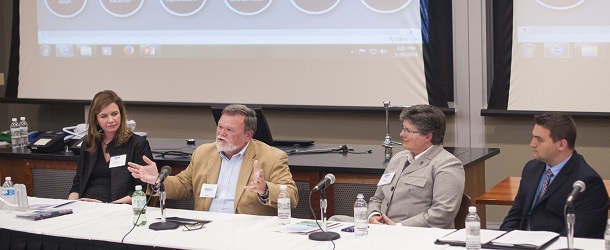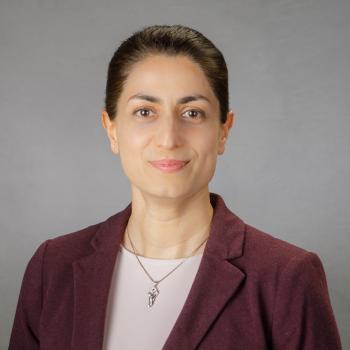State of the Region Conference at OHIO highlights region’s manufacturing industry
From Ohio University's Compass
Business and community leaders across Southeastern Ohio discussed the state of the Appalachian region’s manufacturing sector as it relates to the national economy in Ohio University’s Walter Hall on May 20, and heard a mix of success stories as well as challenges rife with opportunities to overcome.
This year marked the third year for the conference, and afforded local leaders an opportunity to network and hear from government officials about the resources available to help their businesses, as well as learn about national issues affecting the region.
Matt Erskine, deputy assistant secretary for economic development in the U.S. Economic Development Administration and a member of the Obama Administration, highlighted some of the things the administration is doing to help create job growth and manufacturing opportunities across the nation and state. This includes co-investment of $45 million for economic development initiatives in Ohio since 2009, he noted.
“This focus on manufacturing is timely, both for Ohio, the nation, and the Appalachian region,” he told the large crowd of more than 200 people. “Here in Ohio, 1 in 7 people in the Appalachian Region work in the manufacturing industry, and 1 in 10 Ohio jobs are manufacturing-related.”
Erskine gave a brief overview of the decline of manufacturing that has taken place across the county since 2001 when the United States had its first trade deficit in advanced technology, he said. “Research indicates this is due in large part to what we call the ‘missing middle’ in the U.S. ecosystem. In other words, the companies with the ability to scale up products to the marketplace have been losing their edge turning research results into commercially marketed products,” Erskine said.
A recent study by the Massachusetts Institute of Technology concluded the missing middle exists because of a manufacturing trend in the 1990s and 2000s to outsource production to other countries in an effort to control labor costs, he added. Outsourcing hollowed out the nation’s manufacturing capability, weakened the domestic supply chain and created a loss of U.S. jobs.
Since then, higher energy costs to transport goods and services have started a transition phase in which manufacturers are looking at the larger picture when it comes to producing their goods, he said, and some companies are returning to the United States.
“We’re seeing signs of progress, the economy is growing, the deficit in advanced technology decreased in 2012 and 2013, and manufacturers have added more than 620,000 jobs in the last four years,” Erskine said. “It’s no longer just about low wages. It’s about the total cost-benefit for the enterprise, considering all factors.”
Overseas manufacturers appreciate Americans strong, dependable supply chains, as well as the ability to access domestic energy, the rule of law, and an innovative and productive work force, he said.
President Barack Obama is committed to helping companies and universities collaborate in order to move technologies to the marketplace and create an innovative ecosystem where industry and academia can work together to rebuild the industry’s manufacturing base, Erskine said, noting that 20 collaborated research projects are currently underway — including one in Youngstown, Ohio.
“The president has announced that four new manufacturing innovation hubs will be launched this year, starting with advanced composites, and bipartisan legislation has support in both the House and the Senate, and we are working closely with them to send the legislation to the president this year,” he said. “The vision is a network of regional institutes with regional focus and a national impact, each committed to a different manufacturing technology which will help strengthen the supply chain.”
Other regions in the world are making game-changing investments in education and innovation, he noted. “Germany has 60 manufacturing hubs. America can’t afford to be left behind and I encourage Ohio University to be heard on this issue.”
Keynote speaker Charles Wessner, director of technology, innovation and entrepreneurship at U.S. National Academies, delivered a presentation that emphasized the United States should strongly consider its investments in education so it doesn’t fall farther behind other nations.
“The rest of the world understands how important innovation is to growing and attaining a country’s position,” he said. “Collaboration is essential for innovation, and universities are playing a growing role in that process.”
China is investing in building first-class infrastructure and universities, is sending more students to universities and is raising spending levels for education. China, South Korea, Germany and the European Union spend more on education than the United States, he noted.
Wessner suggested the United States needs to invest more in education, and provide additional funding for new companies hoping to market new technologies created by universities through research and development.
Despite his misgivings, Wessner said one-third of all research taking place worldwide is taking place within the United States. “We’re focused on research, and not on brick and mortar projects to maintain buildings, as in Europe,” he said. “We have strengths the rest of the world wants to have but has a hard time getting. We are generally accepting of science, and actually value commercial success.”
Green energy in particular is a huge investment opportunity, and one which is strongly being pushed by the Obama Administration, he noted. “It’s a huge investment opportunity the entire world is trying to take from us. Green energy is where the world is going,” he said, adding that the United States has inexpensive energy sources compared to other countries.
“Government needs to love the University, and the University needs to love the businesses around it,” he emphasized. “We need to support the manufacturing base and reach out hard to Washington. Fight for your piece of the pie and make sure that there’s a pie. We need more research and development. We need to work, we need to invest, we need to cooperate and be serious about the future. Our future, this region’s future, quite literally, is on you. There’s no one else.”
For additional information including success stories shared and photos click here.



